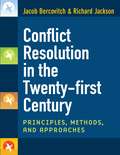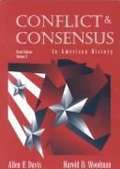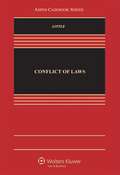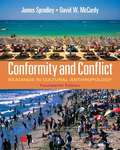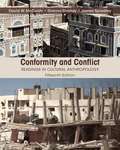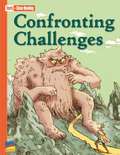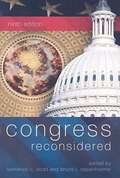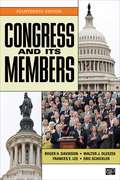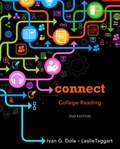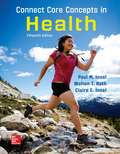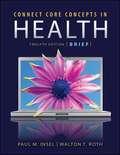- Table View
- List View
Conflict Of Laws (Examples And Explanations)
by Michael H. HoffheimerA favorite among successful students, and often recommended by professors, the unique Examples & Explanations series gives you extremely clear introductions to concepts followed by realistic examples that mirror those presented in the classroom throughout the semester. Use at the beginning and midway through the semester to deepen your understanding through clear explanations, corresponding hypothetical fact patterns, and analysis. Then use to study for finals by reviewing the hypotheticals as well as the structure and reasoning behind the accompanying analysis. Designed to complement your casebook, the trusted Examples & Explanations titles get right to the point in a conversational, often humorous style that helps you learn the material each step of the way and prepare for the exam at the end of the course. Clear, informal, and even humorous, Examples & Explanations: Conflicts of Law, 3E, explores all of the topics covered in Conflicts courses, including personal jurisdiction and the Erie doctrine. It provides full treatment of traditional and modern approaches to choice of law and proof of law, with up-to-date coverage of constitutional limits. Big-picture overviews and accurate statement rules are reinforced with concrete examples and test-taking tips. The powerful Examples & Explanations pedagogy works especially well for Conflict of Laws where students gain understanding of rules and policies by applying them to new fact patterns. Summaries of leading cases found in most casebooks and a modular organization allows easy adaptation to any course. The Third Edition adds new Supreme Court decisions, provides a new chapter on transfers and forum non conveniens, and adds coverage of the new European Union rules on inheritance and wills.
Conflict Resolution in the Twenty-first Century: Principles, Methods, and Approaches
by Jacob Bercovitch Richard Jackson"An outstanding overview and assessment of contemporary conflict resolution; the authors never avoid the challenging questions, or critical answers. " ---Åshild Kolås, Program Leader, Conflict Resolution and Peacebuilding Program, International Peace Research Institute, Oslo (PRIO) "Conflict Resolution in the Twenty-first Centuryis very readable and crystallizes the breadth of conflict resolution today and the relevance of new approaches for the future. " ---Jeffrey W. Helsing, Deputy Director, Education and Training Center, United States Institute of Peace "This concise and readable volume offers readers an impressive sample of the responses---both traditional and emerging---in the conflict resolution toolbox, crisply outlining how they relate to today's dynamic conflict environment. " ---Chester A. Crocker, James R. Schlesinger Professor of Strategic Studies, Edmund A. Walsh School of Foreign Service, Georgetown University "Authoritative, well written, and astoundingly broad and deep. Must-reading for all students of international and ethnopolitical conflict resolution. " ---Dean G. Pruitt, Distinguished Scholar in Residence, Institute for Conflict Analysis and Resolution, George Mason University "The idea that the nature and methods of conflict resolution ought to change as the kinds of conflict that dominate the world-at-large shift is very appealing. " ---Professor Lawrence Susskind, Director, MIT-Harvard Public Disputes Program "A comprehensive overview, based upon in depth familiarity with the research, scholarship, and practice in the field. " ---Louis Kriesberg, Professor Emeritus of Sociology and Maxwell Professor Emeritus of Social Conflict Studies, Syracuse University In the past, arbitration, direct bargaining, the use of intermediaries, and deference to international institutions were relatively successful tools for managing interstate conflict. In the face of terrorism, intrastate wars, and the multitude of other threats in the post-Cold War era, however, the conflict resolution tool kit must include preventive diplomacy, humanitarian intervention, regional task-sharing, and truth commissions. Here, Jacob Bercovitch and Richard Jackson, two internationally recognized experts, systematically examine each one of these conflict resolution tools and describe how it works and in what conflict situations it is most likely to be effective. Conflict Resolution in the Twenty-first Centuryis not only an essential introduction for students and scholars, it is a must-have guide for the men and women entrusted with creating stability and security in our changing world. Jacob Bercovitch is Professor of International Relations at the University of Canterbury, New Zealand. Richard Jackson is Reader in International Politics at Aberystwyth University, United Kingdom. Cover illustration © iStockphoto. com
Conflict and Consensus in Modern American History, Volume 2
by Harold D. Woodman Allan DavisA look at American politics during the last 150 years and a discussion of the developments in political theory.
Conflicts That Shaped a Nation: Unit Seven
by Benchmark Education CompanyNIMAC-sourced textbook <p>Grade Nine</p>
Conflicts of Law: Cases, Materials, and Problems (Aspen Casebook Series)
by Laura E. LittleAward-winning teacher Laura Little offers a progressive, innovative approach to teaching complex material in the new casebook, Conflict of Laws. In a subject where there are few "right" answers and plenty of room for debate, this casebook offers a contemporary alternative to the subject by connecting coverage of key issues and concepts to law practice using modern cases-and-problem pedagogy. Features: Award-winning teacher and respected author Laura Little brings her considerable expertise in federal courts, conflict of laws, and constitutional law to the subject. Well-balanced casebook presents the deep jurisprudential lessons imbedded in the conflict of laws subject matter. Proven cases-and-problems pedagogy helps students apply concepts. Maintains a clear presentation of doctrines relevant to current law practice. Thematic approach puts conflicts of law in the context of actual issues confronted in law practice. Clear, straightforward writing avoids the "hide the ball" approach of many other books and maximizes accessibility to difficult material. Innovative organization, beginning with personal jurisdiction, follows the way issues arise in litigation and highlights the importance of forum selection. Highly adaptable modular presentation allows professors to customize approach. Contemporary cases and hypotheticals allow students to apply rules to current situations, while hallmark cases maintain continuity with the development of the discipline. Full coverage of current topics such as Internet issues, same-sex marriage, choice of law clauses, and class actions. International and comparative materials cover global aspects of conflicts. Emphasis on the Restatement (Second) of Conflicts, now the predominant United States approach but insufficiently covered in most other texts. Online PowerPoint slides, charts, and diagrams support teachability. Comprehensive Teachers Manual includes answers to every problem, teaching suggestions, sample syllabi, and a graphical depiction of each main case, as well as unique insights and case backgrounds.
Conformity And Conflict: Readings In Cultural Anthropology
by James Spradley David W. MccurdyDemonstrate the nature of culture and its influence on people's lives. For over 40 years, the best-selling Conformity and Conflict has brought together original readings and cutting edge research alongside classic works as a powerful way to study human behavior and events. Its readings cover a broad range of theoretical perspectives and demonstrate basic anthropological concepts. The Fourteenth Edition incorporates successful articles from past editions and fresh ideas from the field to show fascinating perspectives on the human experience. Teaching and Learning Experience Personalize Learning -MyAnthroLab delivers proven results in helping students succeed, provides engaging experiences that personalize learning, and comes from a trusted partner with educational expertise and a deep commitment to helping students and instructors achieve their goals. Improve Critical Thinking -Articles, article introductions and review questions encourage students to examine their assumptions, discern hidden values, evaluate evidence, assess their conclusions, and more! Engage Students -Section parts, key terms, maps, a glossary and subject index all spark student interest and illustrate the reader's main points with examples and visuals from daily life. Support Instructors -Teaching your course just got easier! You can create a Customized Text or use our Instructor's Manual, Electronic "MyTest" Test Bank or PowerPoint Presentation Slides. Additionally, Conformity and Conflict's part introductions parallel the basic concepts taught in introductory courses - which allow the book to be used alone as a reader or in conjunction with a main text. Note:MyAnthroLab does not come automatically packaged with this text. To purchase MyAnthroLab, please visitwww. MyAnthroLab. comor you can purchase a valuepack of the text + MyAnthroLab (at no additional cost): VP ISBN-10: 0205176011/ISBN-13: 9780205176014
Conformity and Conflict: Readings in Cultural Anthropology, Fifteenth Edition
by James Spradley David W. McCurdy Dianna ShandyExamine Culture and its Influence on Human Life Conformity and Conflict: Readings in Cultural Anthropology seeks to teach readers the importance of culture and its influence on human life. By including examples of Western, North American cultures, the text makes cultural understanding and comparison more relatable to audiences. The inclusion of current information and articles allows readers to connect with major anthropological concepts through relevant events. <P><P>The Fifteenth Edition reflects the changing nature of the discipline of anthropology by shifting its focusing to the more concerning issues of today. Useful features like a glossary of key terms help readers understand basic concepts discussed in the readings. Articles throughout the text touch on all major subfields, including environmental, global, and medical topics, giving readers a comprehensive introduction to the field.
Confronting Power: The Practice of Policy Advocacy
by Jeff UnsickerConfronting Power provides an academically rigorous, yet practical and comprehensive framework and sets of concepts for planning, implementing and evaluating policy advocacy. Based on the author's experiences both as teacher and activist, the framework is general enough to be relevant for advocacy in a variety of sectors such as poverty alleviation, human rights and the environment, in different national and cultural contexts, and at levels ranging from influencing a town council to transnational institutions such as the World Bank. The book grounds the concepts via a series of case studies, which themselves illustrate a range of different advocacy campaigns in both the Global South and the United States. Designed to be both a textbook and a guide for practical action, Confronting Power should become an essential component of every teacher and social advocate's tool kit.
Congress Reconsidered, 9th Edition
by Bruce I. Oppenheimer Lawrence C. DoddAlways a classic, Dodd and Oppenheimer's Congress Reconsidered is the recognized source for in-depth, cutting-edge scholarship on Congress geared to undergraduates. Thoroughly updated -- with ten brand new pieces and the others completely revised -- this ninth edition includes cogent, timely analysis of the 2008 congressional elections, as well as coverage of: <P><P> * the 110th Democratic Congress,specifically its energy policy, its handling of the Iraq War, and its taxing and spending; <P> * the role of committees in Congress; <P> * leadership by women and minorities in Congress; <P> * the effects of campaign finance reform; <P> * differences in legislative activity between the Republican and Democratic Congresses; <P> * party coalition-building across the postwar era; <P> * and perspective on campaigns, elections,and political careers from member of Congress Daniel Lipinski.
Congress and Its Members (14th Edition)
by Frances E. Lee Eric Schickler Roger H. Davidson Walter J. OleszekThis book is meant for general readers seeking an introduction to the modern Congress as well as for college or university students taking courses on the legislative process or national policy making.
Congress, The Bureaucracy, And Public Policy
by Randall B. Ripley Grace A. FranklinRipley is Professor of political science and dean of the College of Social and Behavioral Sciences at Ohio State University. This book can be a core text or supplement for a political science course on the legislative branch.
Connect College Reading (2nd Edition)
by Ivan G. Dole Leslie TaggartTaking a holistic approach to developmental reading, CONNECT: COLLEGE READING is an intermediate level book for reading levels 8-10. CONNECT strives to build students' confidence by showing them that many of the skills needed to become stronger readers are skills they already possess and use on a daily basis. Using popular media as a springboard, Dole and Taggart show students how thinking skills used while watching television or movies can easily transfer to reading. CONNECT's comprehensive approach includes extensive vocabulary coverage, critical thinking practice throughout, and textbook readings in every chapter to help students master college reading. The second edition includes a full chapter on inferences, enhanced coverage of main idea, and guides for specialized reading situations such as reading visuals, novels, and a guide to taking tests.
Connect Core Concepts In Health (Fifteenth Edition)
by Walton T. Roth Paul M. InselLet’s focus on the science of Health! ConnectCore Concepts in Health integrates innovative learning technologies and thelatest scientifically driven information to create a complete instructionalsystem for students and teachers. Withup-to-date coverage in every chapter Connect Core Concepts in Healthencourages students to reflect on their choices as a foundation for ahealthy life.
Connect Core Concepts in Health, Brief
by Walton T. Roth Paul M. InselThe most reliable and widely used personal health text, Connect Core Concepts in Health utilizes the theme of personal responsibility to teach and motivate students about health and wellness. The twelfth edition provides current, accurate, scientifically based information about a wealth of health and wellness topics and issues. Connect Personal Health is now seamlessly and deeply integrated with Blackboard and Blackboard related course management systems. Connect is an interactive online learning system that provides interactive multimedia-driven activities and assessments, such as interactive quizzes, video activities, health assessments, Internet research activities, online behavior change workbook, a fitness and nutrition log, and a multimedia ebook. Most activities and assessments are auto graded, entered into the grade book, and automatically uploaded to blackboard. This saves you time, holds your students accountable, and allows for seamless Course Management integration. Only one sign-on is needed for access to Blackboard and Connect, the grade book is integrated, and much much more. To address today's students' need for more portable, more relevant classroom tools, we are providing the book in a three-hole punched, loose-leaf version. Ask your rep for the correct ISBN to also provide each student full access to Connect Plus and the multimedia e-book at no extra charge with each copy of the loose-leaf text.
Connect: Bringing Faith to Life
by St. Mary'S PressOne student book for a comprehensive 3-year program. Includes eLearning lessons for all three years. Integral to the 3-year interactive program that presents the core teaching of the Catholic faith to young people in grades 6 through 8. Special, unique and relevant Life Issue lessons help young people see life through the lens of faith. It's easy to navigate with color-coded sections and roadmaps to see what's covered in each year.
Connected Mathematics 2, Grade Eight
by Glenda Lappan James T. Fey William M. FitzgeraldNIMAC-sourced textbook
Connected Mathematics 2, Grade Seven
by Glenda Lappan James T. Fey William M. FitzgeraldNIMAC-sourced textbook

